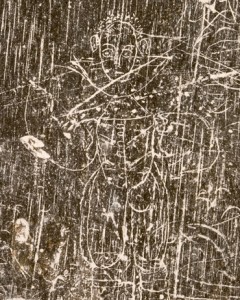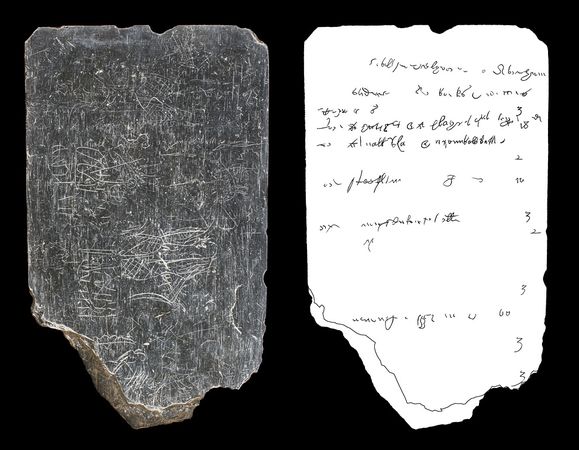 Last June, archaeologists excavating the James Fort area of Jamestown, Virginia, found a 400-year-old slate tablet covered on both sides in words, numbers, etchings of people and animals. It was found in a well believed to have been dug in 1609 by Captain John Smith himself, although it had become brackish within a couple of years and served as a trash pit for the settlers.
Last June, archaeologists excavating the James Fort area of Jamestown, Virginia, found a 400-year-old slate tablet covered on both sides in words, numbers, etchings of people and animals. It was found in a well believed to have been dug in 1609 by Captain John Smith himself, although it had become brackish within a couple of years and served as a trash pit for the settlers.
Jamestown was the first permanent English settlement in America and this tablet is the first found with extensive inscriptions from the early colonial period. It has been studied assiduously in the 7 months since its find, most recently by examining digitally enhanced images of the complex engravings.
The enhancements have helped researchers identify a 16th-century writing style used on the slate and discern new symbols, researchers announced last week. The characters may be from an obscure Algonquian Indian alphabet created by an English scientist to help explorers pronounce the language spoken by the Virginia Indians.
“Just like finding the Rosetta Stone led to a better understanding of the Egyptians, this tablet is beginning to add significantly to our understanding of the earliest years at Jamestown,” [director of research and interpretation at Historic Jamestowne William] Kelso said. It conveys messages about literacy, art, symbols and signs personally communicated by the colonists who used it, he explained.
The digital images were made by curators at the Smithsonian’s Museum Conservation Institute using a technique called reflectance transformation imaging, which takes hundreds of high-res pictures of the surface of the tablet under different angled lights. This emphasizes different grooves on the tablet’s surface. It’s like when you tilt your head and hunker down and narrow your eyes to find any marks you couldn’t see looking straight down on a shiny surface.
Can you tell I just kneaded some dough on a granite countertop? Only this is even worse because many of the images were made with a slate pencil on the slate surface, so they’re gray-on-gray and hard to see with the naked eye under any circumstance.
The Elizabethan specialists have found the words “Abraham” and “book” as well as some individual letters, but since the tablet was reused, there are many missing parts. The Elizabethan writing is in secretary’s hand, which supports Kelso’s theory that the tablet belonged to William Strachey, the first secretary of the Jamestown colony.
There’s drawing of a Palmetto tree and what may be a cahow, a rare sea bird found only in Bermuda. Strachey was stranded in Bermuda for 10 months on his way to Virginia.

Interesting, but I don’t understand why a “Rosetta Stone” this tablet. Are there any untranslated/incomprehensible Algonquian texts?
I don’t think so, although there are many English words that are derived from Algonquin originals. There are no extant Algonquian dictionaries, however. The last known one was destroyed in a fire in 1666.
The Rosetta Stone description in this case applies only in the sense that the tablet may provide translations for two languages that haven’t been used in hundreds of years, Elizabethan English and Algonquin. It’s tenuous, I know.
i really, honestly i reallly love the information :chicken: i am a fan of history. i like burgers and i am from the mean streets of l.a. my name is joey!
-Joey is out! :chicken:
I like a good burger myself. Glad you’re enjoying the blog. :hattip:
The Virginia Gazette newspaper of January 16th gave a bit more insight into how the professional archaeologist at Jamestown became aware of the similarity of characters on the tablet to the phonetic alphabet of Thomas Harriot.
It seems that a Williamsburg author had written in 2007 that Captain John Smith and George Percy, two of the original Virginia Adventurers, may have had access to Harriot and his dictionary of Algonquian language.
This author also demonstrated the likelihood that George Percy would have known Harriot, who lived in his brother’s household.
A few months ago, the author was giving a lecture on Thomas Harriot and showed the phonetic alphabet to the class. One of the students, a volunteer at Jamestown, noticed the similarity to characters on the tablet and made the staff archaeologist at Jamestown aware of the possibility that some of the characters came from Harriot’s phonetic alphabet.
This shows the valuable contribution of research done by the author and the intitiative of one of his students helped Jamestown staff connect the dots in this mystery.
That’s fantastic. The article I quoted above skipped the student link altogether. That student can die happy now.
Thank you kindly for the info. :thanks: